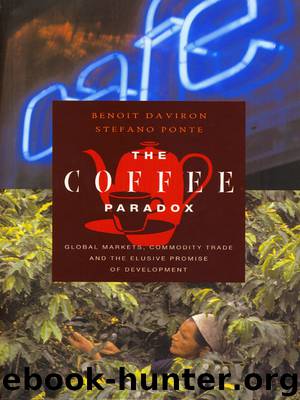The Coffee Paradox by Ponte Stefano Daviron Benoit

Author:Ponte, Stefano, Daviron, Benoit
Language: eng
Format: epub
Publisher: Zed Books
Published: 2013-09-22T04:00:00+00:00
Some interim reflections
According a well-respected actor in the Italian coffee market,
the clientele is ignorant [about coffee quality]. If consumers understood more about coffee, like they do about wine, then roasters would have to provide a better product. The big industrial roasters do not want that to happen.8
This view is echoed by another key figure in the industry, who stated that ‘roasters have no interest in spreading the culture of origins because they want to defend their brands. They do not want consumers to identify coffee as Kenyan, but as Lavazza.’9 Given this situation, attempts by developing countries to add value to their coffees through higher-quality offerings and geographical appellations have limited prospects of success.
Yet the Illy story demonstrates that high-quality supply can turn markets around and that consumers are available to pay for quality. At the same time, the quality message of Illy to its consumers is related to a brand, not to coffee origins. Its product is homogeneous and mass-marketed. It is also not clear to what extent consumers appreciate quality in terms of the purported excellence of material coffee attributes and to what extent they like the limited-release cups and shining silver cans.
From a development perspective, a couple of questions come to mind. What kind of in-person services, styles, designs and stories can be sold by producing-country actors? How can value-added be transferred to them without excessive appropriation by other actors along the value chain? Do higher-quality roasters pay higher prices for the coffee they buy? From whom do they source coffee?
Coffee exporters in East Africa consider Illy one of the toughest buyers in terms of quality, but one that pays up to twice the market rate for high-quality coffee. The problem is that most smallholder suppliers cannot match Illy’s standards. In 2000 inTanzania, for example, Illy was purchasing from only one estate in Kilimanjaro – owned by an Italian. In Brazil and other countries of origin, with the exception of Ethiopia, Illy buys most of its coffee from estates. What does this mean for smallholders, producing countries’ development strategies, and future prospects for coffee farmers in general? How much of the value added in high-quality coffee markets is credited to the producer? What kind of producer? In the rest of this section, we will ask a similar set of questions in relation to the North American specialty industry. Chapter 5 will extend the analysis to sustainable coffees. In Chapter 6, we will provide some examples of the distribution of the value added in mainstream and specialty markets.
Download
This site does not store any files on its server. We only index and link to content provided by other sites. Please contact the content providers to delete copyright contents if any and email us, we'll remove relevant links or contents immediately.
Life 3.0: Being Human in the Age of Artificial Intelligence by Tegmark Max(5193)
The Sports Rules Book by Human Kinetics(4079)
The Age of Surveillance Capitalism by Shoshana Zuboff(3991)
ACT Math For Dummies by Zegarelli Mark(3855)
Blood, Sweat, and Pixels by Jason Schreier(3498)
Unlabel: Selling You Without Selling Out by Marc Ecko(3474)
Hidden Persuasion: 33 psychological influence techniques in advertising by Marc Andrews & Matthijs van Leeuwen & Rick van Baaren(3302)
Urban Outlaw by Magnus Walker(3246)
The Pixar Touch by David A. Price(3220)
Bad Pharma by Ben Goldacre(3102)
Project Animal Farm: An Accidental Journey into the Secret World of Farming and the Truth About Our Food by Sonia Faruqi(3019)
Brotopia by Emily Chang(2899)
Kitchen confidential by Anthony Bourdain(2834)
Slugfest by Reed Tucker(2807)
The Content Trap by Bharat Anand(2781)
The Airbnb Story by Leigh Gallagher(2707)
Coffee for One by KJ Fallon(2423)
Smuggler's Cove: Exotic Cocktails, Rum, and the Cult of Tiki by Martin Cate & Rebecca Cate(2340)
Beer is proof God loves us by Charles W. Bamforth(2252)
